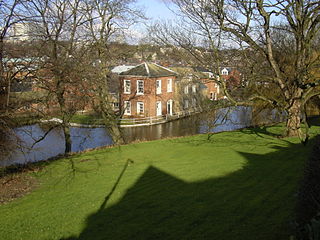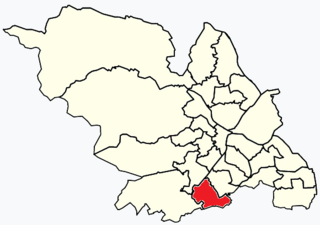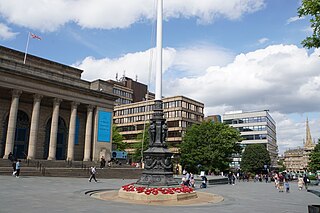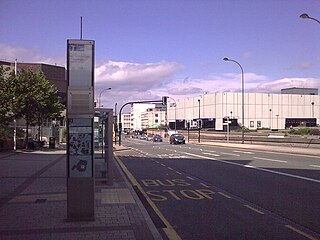
The River Sheaf in Sheffield, South Yorkshire, England, flows northwards, past Dore, through Abbeydale and north of Heeley. It then passes into a culvert, through which it flows under the centre of Sheffield before joining the River Don. This lower section of the River Sheaf, together with the Don between the Blonk Street and Lady's Bridges, formed two sides of the boundary of Sheffield Castle.

The Porter Brook is a river which flows through the City of Sheffield, England, descending over 1,000 feet (300 m) from its source on Burbage Moor to the west of the city to its mouth where it joins the River Sheaf in a culvert beneath Sheffield railway station. Like the other rivers in Sheffield, its steep gradient made it ideal for powering water mills and works associated with the metalworking and cutlery industries, and around 20 dams were constructed over the centuries to facilitate this. At its lower end, it is extensively culverted, but parts of it are gradually being restored to open channels, as part of a daylighting scheme for the city.

Sheffield station is a combined railway station and tram stop in Sheffield, England; it is the busiest station in South Yorkshire, and the second busiest in Yorkshire & the Humber, after Leeds. Adjacent is the Sheffield Supertram stop.

Ponds Forge International Sports Centre is a leisure complex in Sheffield, England. It has an Olympic-sized swimming pool with 2,600 seating capacity, a family and children's pools, water slides amongst other facilities.

Beauchief and Greenhill ward—which includes the districts of Batemoor, Beauchief, Chancet Wood, Greenhill, Jordanthorpe, Lowedges and Meadowhead—is one of the 28 electoral wards in the City of Sheffield, England. It is in the southern part of the city and covers an area of 2.4 square miles (6.2 km2). The population of the ward in 2016 was estimated to be 19,669 people in 9,209 houses.

The Cultural Industries Quarter is a district in the city centre of Sheffield, England, and one of the eleven Quarters designated in the 1994 City Centre Strategy. It is roughly triangular in shape, and is bound by Howard Street, Sheaf Square and Suffolk Road to the north-east, St Mary's Road to the south and Eyre Street and Arundel Gate to the north-west, with Granville Square in the south-east. The name given reflects the intention to create a cluster of music, film and science-based businesses in the area.

Fitzalan Square is a municipal square situated in the city centre of Sheffield in South Yorkshire, England. The present day square is one of the busiest areas of the city centre, with traffic and pedestrians continually moving through the area. It has a Sheffield Supertram stop and a taxi rank.

Barker's Pool is a public city square and street in the centre of Sheffield, England. The focus of Barker's Pool is the Grade II* listed 90-foot-tall (27 m) war memorial that was unveiled on 28 October 1925 to commemorate the First World War. The Grade II* listed Sheffield City Hall is on the north side of the plaza facing the Grade II listed former John Lewis & Partners department store.

Sheaf House was a nine-storey tower building by Sheaf Square, next to Sheffield railway station, in the centre of Sheffield, in South Yorkshire, England. The building was formerly the Sheffield area headquarters of British Rail.

Dyson House was a building which was part of Sheffield Hallam University's city campus in Sheffield, South Yorkshire, England. The building was on Sheaf Square, next to the Sheffield Midland Station. Dyson House became unused by the university for several years, and was bought by Yorkshire Forward as part of the Heart of the city scheme funded by EU regeneration money and was demolished in 2006. The site along with the adjacent Sheaf House has a proposal for a new 200,000 sq ft (19,000 m2) office block, shops and 200 apartments in a mixed use scheme of a futuristic modern design by Make Architects designers of the acclaimed Swiss Re (Gerkin) building in London.
Buildings and structures in Sheffield have been constructed over a time-span ranging from the 13th century to the present day. The majority of Sheffield's older buildings were built during the Industrial Revolution, with many medieval buildings demolished in the 19th century; some older buildings were lost during the Sheffield Blitz. Sheffield can only lay claim to five Grade I listed buildings, two of which are in the city centre.

The Old Hay Brook is a small river in Sheffield, South Yorkshire, England. It is formed from the Redcar Brook, Blacka Dike and another stream, which rise on moors to the south of Sheffield, and is joined by Needham's Dyke near Totley Grange. At Totley Rise it joins Totley Brook, to become the River Sheaf. Water from the river was used to power mills processing lead, corn and paper from at least the 17th century, which were later used for grinding scythes as the Sheffield metal industry expanded. All the mills were defunct by 1900, although some remnants including weirs and dams are still visible.

Sheffield City Centre is a district of the City of Sheffield and is covered partly by the City ward of the City of Sheffield. It includes the area that is within a radius of roughly 0.75 miles (1.2 km) of Sheffield Cathedral and is encircled by the Inner Ring Road, a circular route started in the late 1960s and completed in 2007. As well as the cathedral, buildings in the city centre include the Grade I listed Town Hall, the City Hall and the Winter Gardens. Several areas of the city centre have been designated as quarters. It is home to the city's major business, transport, leisure and cultural attractions.

Millennium Square is a modern city square in Sheffield, England. It was created as part of the Heart of the City project that began in 1998 and has become a central feature in Sheffield's redeveloped city centre. It contains fountains in the shape of steel spheres, recalling Sheffield's past as a centre of the steel making industry, whilst linking with the fountains of the Peace Gardens, as well as Sheaf Square, Hallam Square and Barkers Pool. The square forms part of the 'Gold Route', designed by Sheffield City Council to guide visitors through the city centre from Sheffield Station to Devonshire Green.

Howard Street is a street in the city centre of Sheffield, England. It provides a short link between Sheaf Square and one of the great road arteries, Arundel Gate. The street was pedestrianised in 2005 so as to provide safe haven to pedestrians using the railway station. Howard Street is paved all through in granite.
Sheaf Valley Quarter is an area in the centre of Sheffield, England. It is one of Sheffield's 11 designated City Centre Quarters, situated around the rail station and River Sheaf. Its borders are Commercial Street and a bowstring bridge to the north, the railway line to the east, Granville Road to the south (excluding Granville Square, Suffolk Road, Sheaf Square and Howard Street to the south west and Arundel Gate to the west. It is named after the River Sheaf, which flows from the south of the city, underneath the current station and into the River Don and Castlegate. It is one of only 2 quarters with some land outside the ring road.

The Sheffield Digital Campus is a new development in Sheffield City Centre close to the railway station and bus station.
Keiko Mukaide is a Japanese artist who lives and works Fife on the Scottish coast. She was an early winner of a Creative Scotland award and was shortlisted for the 1998 Jerwood Prize for glass.

The Ponderosa is a recreation area within the City of Sheffield, South Yorkshire, England. Although not a public park it was designated as Open Space by Sheffield City Council in the 1993 Unitary Development Plan. It covers an area of over 25 acres (10 ha) and is located at 53.3868°N 1.4865°W, 0.9 miles (1.5 km) west of the city centre between the districts of Upperthorpe and Netherthorpe. Although the name “Ponderosa” was originally an informal name given by local children, it is now the accepted title and is recognised by the local council. Along with Weston Park and Crookes Valley Park it is one of the three “Crookesmoor Parks”.

Arundel Gate is one of the main thoroughfares in Sheffield, England. It is located in the Heart of the City area of Sheffield City Centre. Arundel Gate also features a fifteen-stand bus station, including a ticket office building, completed in 2005.




















